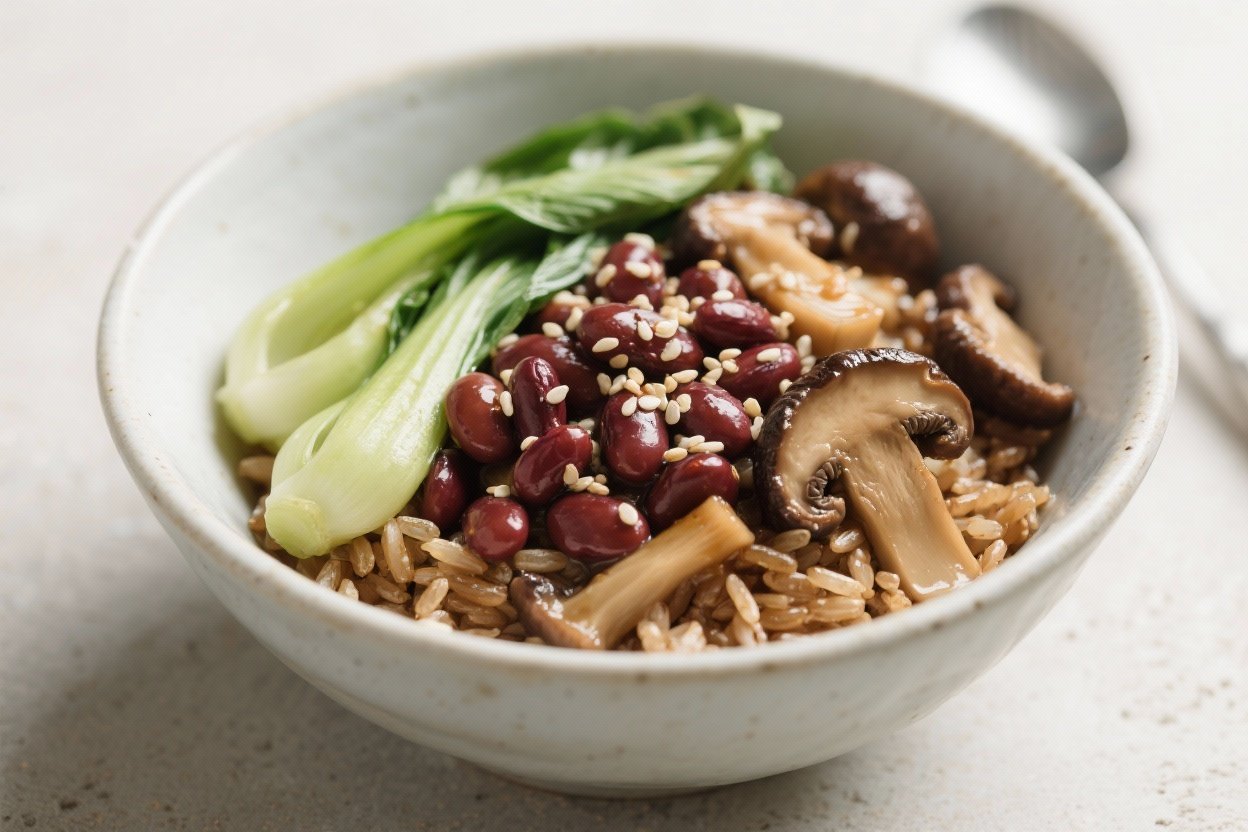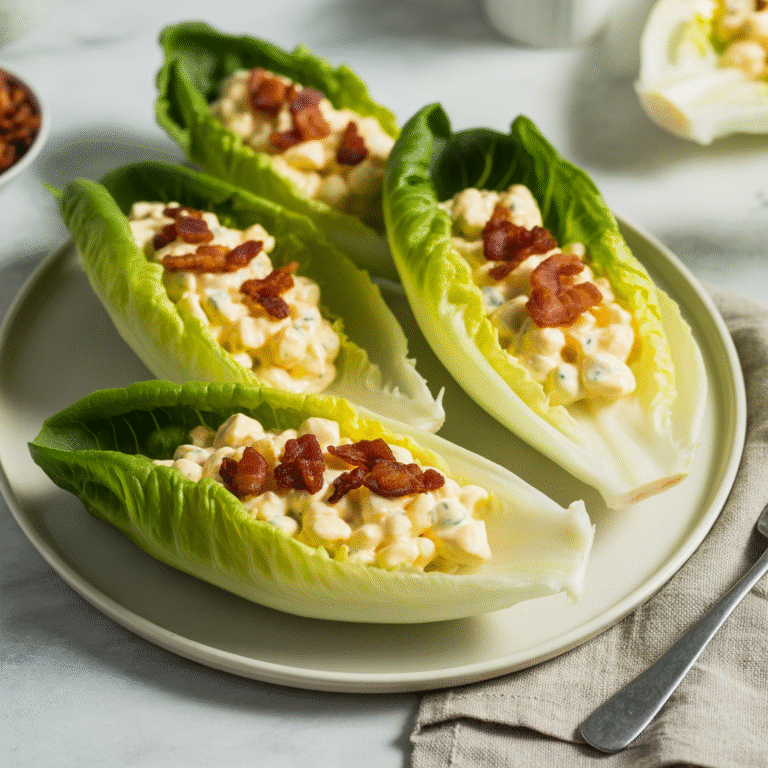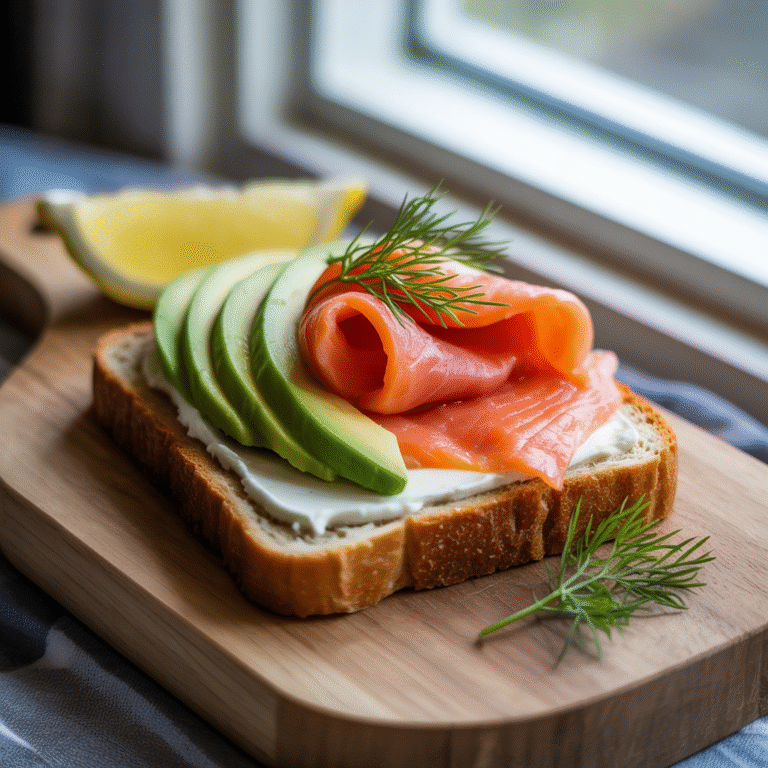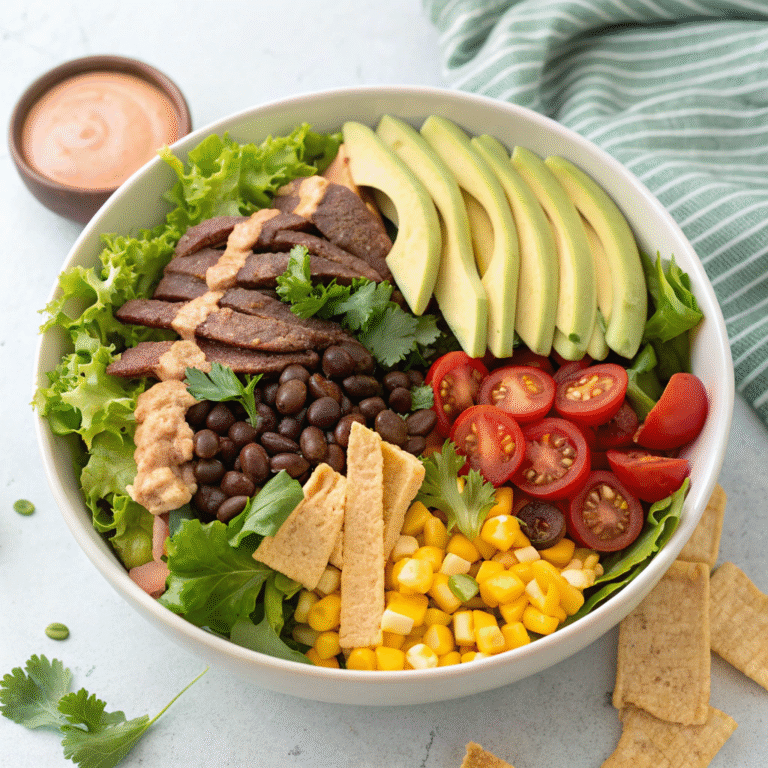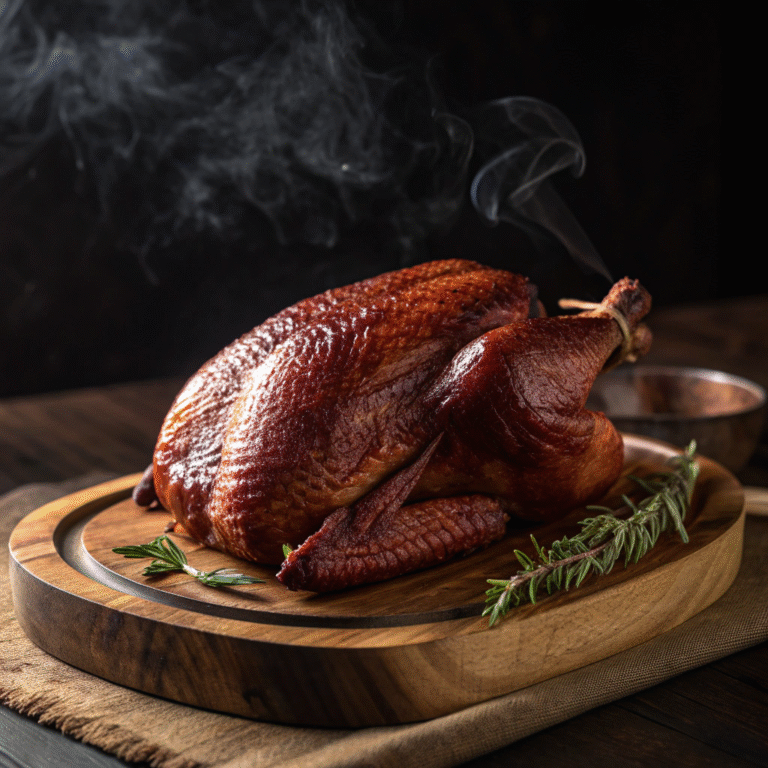Miso Bean Bowl: adzuki beans, bok choy, mushrooms, brown rice, sesame — The Umami Power Lunch You’ll Crave on Repeat
If your lunch tastes like cardboard and regret, this bowl is your exit strategy. It’s loaded with deep umami, clean greens, and slow-burn carbs that power your brain instead of putting it to sleep. We’re talking adzuki beans that digest like a dream, bok choy that brings crunch and brightness, and mushrooms that do their savory magic.
It’s fast enough for a Tuesday, sexy enough for a Sunday, and cheap enough to make your wallet smile. Also: one bowl, minimal dishes, maximum flex.
The Secret Behind This Recipe
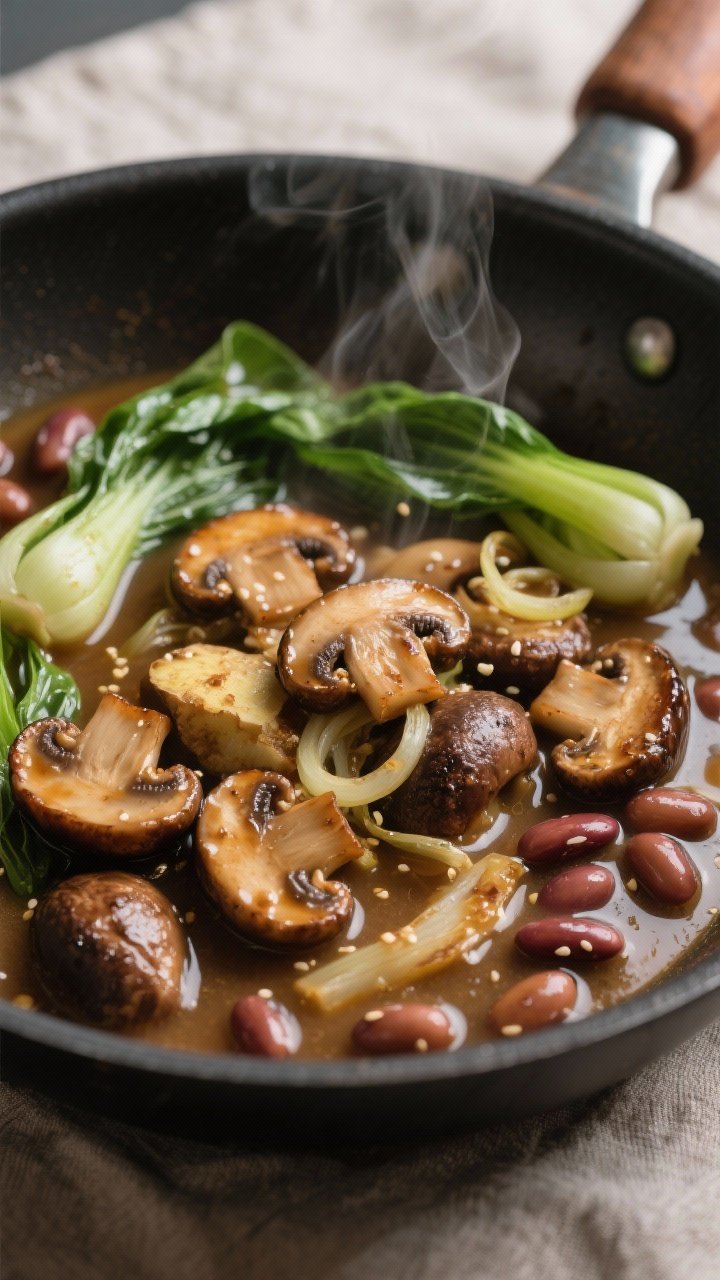
Miso is the anchor. It’s a fermented paste that turns hot water into a broth that tastes like it simmered for six hours.
When it hugs sautéed mushrooms, you get that satisfying, steak-adjacent savoriness without any heavy lift. The adzuki beans add a creamy-core texture and mild sweetness that plays perfectly against salty miso. Bok choy is your fresh counterpoint.
Quick-wilted, it stays crisp-tender and bright. Brown rice lays the foundation, adding fiber and a subtle nuttiness, while sesame (oil and seeds) ties everything together with a toasty finish. The whole combo?
Balanced macros, layered flavor, and a legit restaurant vibe in 25 minutes.
What You’ll Need (Ingredients)
- Cooked brown rice – 2 cups (from about 1 cup dry)
- Adzuki beans – 1 1/2 cups cooked (or 1 can, drained and rinsed)
- Bok choy – 3–4 small heads (or 2 large), chopped into bite-size pieces
- Mushrooms – 8 oz (shiitake, cremini, or mixed), sliced
- Yellow or red onion – 1/2 medium, thinly sliced
- Garlic – 3 cloves, minced
- Fresh ginger – 1-inch piece, grated
- White or yellow miso paste – 2–3 tablespoons
- Low-sodium vegetable broth or water – 1 1/4 cups
- Soy sauce or tamari – 1–2 tablespoons, to taste
- Rice vinegar – 2 teaspoons
- Toasted sesame oil – 1–2 teaspoons
- Sesame seeds – 1 tablespoon (white, black, or mixed)
- Neutral oil – 1 tablespoon (avocado, grapeseed, or canola)
- Optional heat – chili crisp, red pepper flakes, or sriracha
- Optional greens – scallions or cilantro for garnish
Instructions
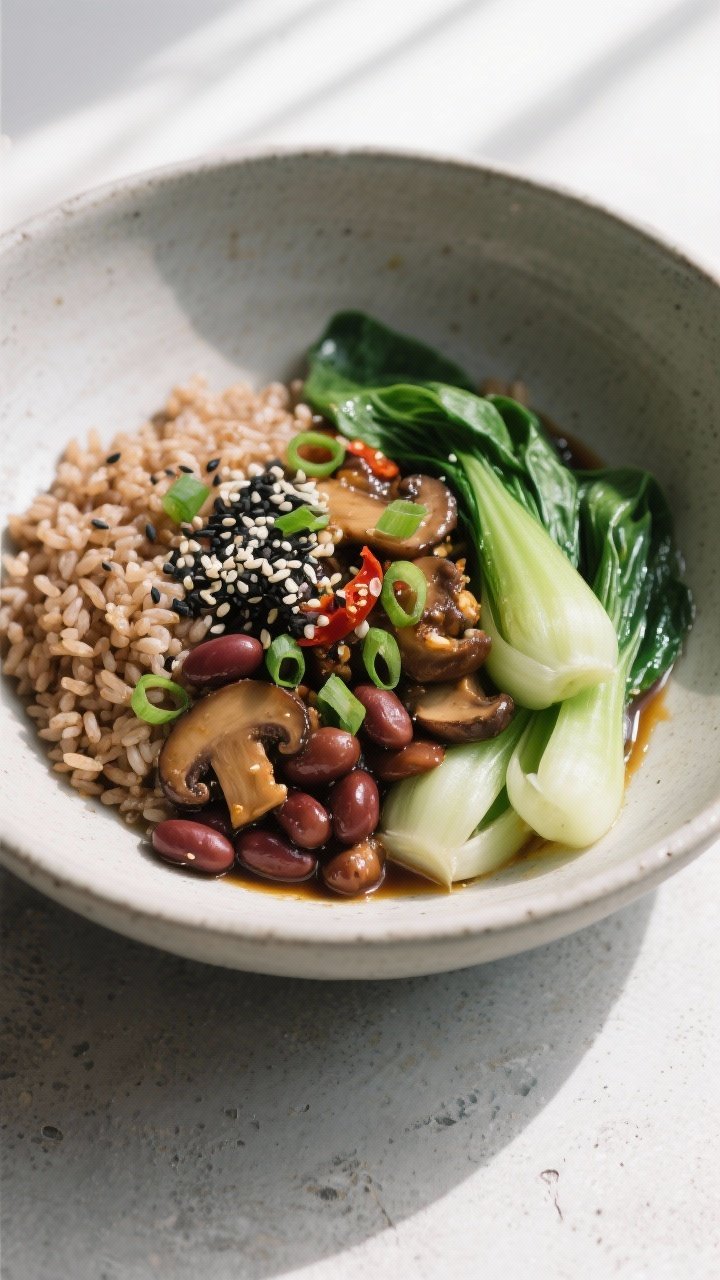
- Prep the base. If you don’t have cooked brown rice ready, start it first. Pro tip: make a big batch on Sunday and you’ll win weeknights.
- Make the miso broth. Warm the broth or water until hot (not boiling). Whisk in miso paste until smooth.
Set aside so you don’t shock the miso with roaring heat.
- Sauté the aromatics. Heat neutral oil in a large skillet over medium-high. Add onion with a pinch of salt; cook 2–3 minutes until translucent. Stir in garlic and ginger for 30 seconds until fragrant.
- Brown the mushrooms. Add mushrooms and cook 4–6 minutes, stirring occasionally, until they release moisture and get some color.
Season with 1 teaspoon soy sauce to deepen flavor.
- Wilt the bok choy. Add chopped bok choy stems first; cook 1 minute. Add leafy parts and a splash of the miso broth; cook 1–2 minutes until just tender but still bright.
- Add the beans. Stir in adzuki beans and remaining miso broth. Simmer gently 2–3 minutes to warm through.
Avoid boiling hard; miso prefers a chill vibe.
- Finish and balance. Add rice vinegar and toasted sesame oil. Taste and adjust with more soy sauce, vinegar, or chili heat. You want savory, lightly sweet, and clean brightness.
- Assemble. Scoop warm brown rice into bowls.
Ladle the miso-braised veg and beans over top. Sprinkle sesame seeds and garnish with scallions or cilantro.
- Optional flex. Drizzle chili crisp for crunch and heat. FYI: it turns this into a “how is this homemade?” moment.
Preservation Guide
- Refrigeration: Store rice and miso-bean mix separately in airtight containers for up to 4 days.
Combining them too early can make the rice soggy.
- Freezing: Freeze the miso-bean-veg mixture (not the rice) for up to 2 months. Thaw overnight in the fridge. Rice can be frozen separately in flat portions for quick defrosting.
- Reheating: Warm gently on the stovetop over medium heat with a splash of water to loosen.
Avoid boiling to keep miso’s flavor and nutrients intact.
- Meal prep tip: Portion into single-serve containers with rice on one side and the miso mixture on the other. Add sesame and scallions after reheating for best texture.
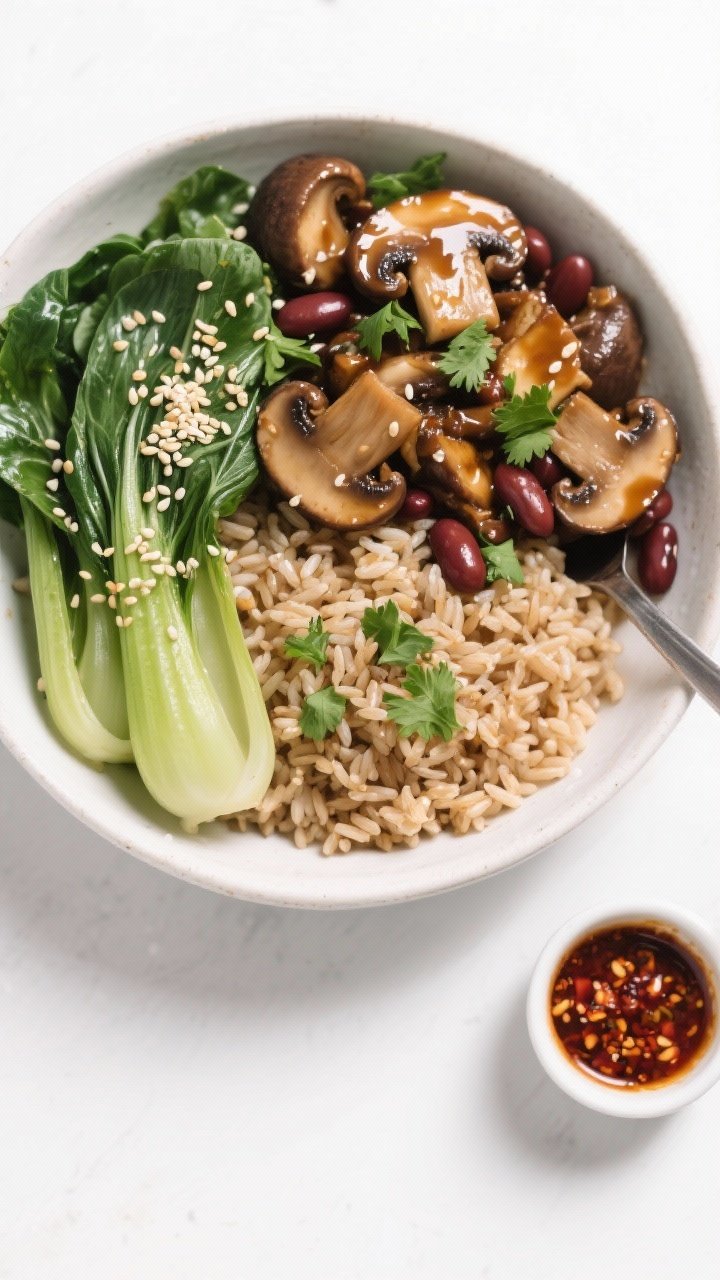
Benefits of This Recipe
- Gut-friendly fermentation: Miso brings beneficial compounds from fermentation, supporting digestion and deep flavor without heavy sauces.
- Protein and fiber synergy: Adzuki beans plus brown rice create a satisfying, complete-feel meal that stabilizes energy and appetite.
- Micronutrient-rich greens: Bok choy delivers vitamin K, A, and C with minimal calories and maximum crunch.
- Umami without excess sodium: Using mushrooms and miso means bold flavor with less salt than typical takeout, IMO.
- Budget-friendly and scalable: Beans and rice are cost-effective; doubling the batch barely changes effort but crushes your weekly lunch game.
Common Mistakes to Avoid
- Boiling the miso: High heat can dull flavor and reduce nutritional benefits. Simmer gently and finish with miso off heat if you’re extra cautious.
- Skipping browning: Mushrooms need contact with the pan to develop flavor.
Don’t crowd the skillet; cook in two batches if needed.
- Overcooking bok choy: It should be crisp-tender, not limp. Stems first, leaves last. Two minutes is plenty.
- Under-seasoning: Taste at the end.
You want a triangle of savory, tangy, and toasty. Adjust soy, vinegar, and sesame oil.
- Using watery rice: Fluffy rice matters. If it’s gummy, spread it on a tray to steam off extra moisture or repurpose as fried rice next time.
Alternatives
- Grain swaps: Quinoa, farro, or cauliflower rice if you’re low-carb.
For extra chew, try short-grain brown rice.
- Protein boosts: Add tofu cubes (pan-seared), tempeh, or a soft-boiled egg. If you eat fish, a miso-glazed salmon works beautifully.
- Mushroom mix-ups: Shiitake for depth, oyster for silkiness, king trumpet for meaty bites. Even button mushrooms work in a pinch.
- Greens galore: Swap bok choy for kale, spinach, napa cabbage, or Swiss chard.
Adjust cook times to avoid mush.
- Sauce spins: Add a spoon of tahini for creaminess, or a dash of mirin for gentle sweetness. Chili oil if you’re spice-forward.
- Bean variety: If adzuki aren’t available, use small red beans, black beans, or even lentils. Adzuki are lighter and sweeter, but you’ll still win.
FAQ
Do I need to soak adzuki beans?
Soaking isn’t required, but it shortens cooking time and can improve digestibility.
If cooking from dry, soak 6–8 hours, then simmer 45–60 minutes until tender. Canned is the quick route and works great.
Which miso should I use?
White (shiro) miso is mild and slightly sweet; yellow is balanced; red is stronger and saltier. For this bowl, white or yellow miso keeps the flavors light and versatile.
Can I make this gluten-free?
Yes.
Use tamari or coconut aminos instead of soy sauce, and confirm your miso brand is gluten-free (some are made with barley).
How do I keep the mushrooms from getting soggy?
Use a hot pan, don’t overcrowd, and add salt midway through browning. Mushrooms release water; let it evaporate before stirring too much.
Is there a way to make it spicier without overpowering the miso?
Yes—finish with chili crisp or a drizzle of sesame-chili oil. Heat on top keeps miso’s delicate flavor intact while giving you that kick.
Can I serve this cold?
Absolutely.
Chill the miso-bean mixture and serve over cold rice or greens for a hearty miso “salad bowl.” Add cucumber and extra rice vinegar for brightness.
What’s the best way to meal prep this for the week?
Batch-cook rice and the miso mix, store separately, and reheat gently. Keep sesame seeds and greens aside to add fresh each day so the textures stay lively.
Can I cook the miso directly in a boiling pot?
You can, but you’ll get a better flavor if you whisk miso into hot (not boiling) liquid and keep the final simmer gentle. Small detail, big payoff.
My Take
This bowl punches way above its weight—barely any prep, but the flavor reads “hours of effort.” The miso-mushroom combo is the hook, and the adzuki beans make it feel substantial without the post-meal slump.
It’s the kind of recipe that sneaks into your weekly rotation because it solves real problems: fast, affordable, nutritious, and honestly addictive. Make it once with proper browning and a smart splash of vinegar at the end, and you’ll wonder why “healthy” ever meant boring.

